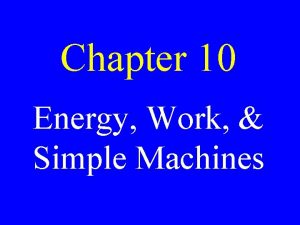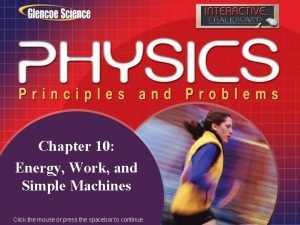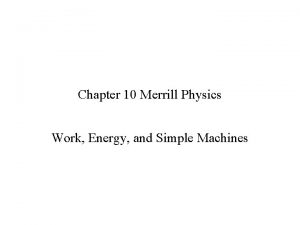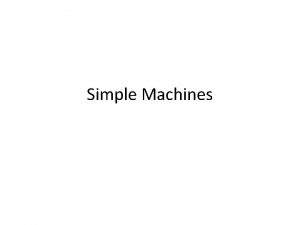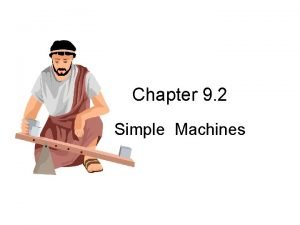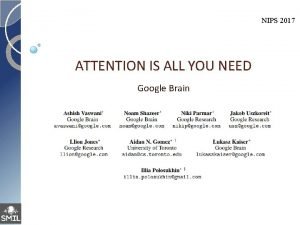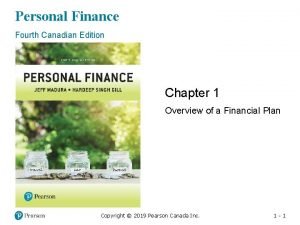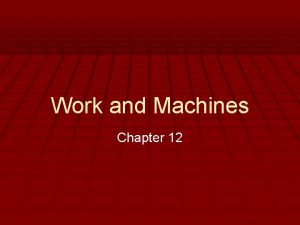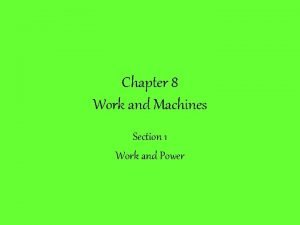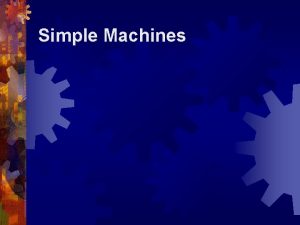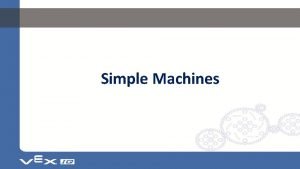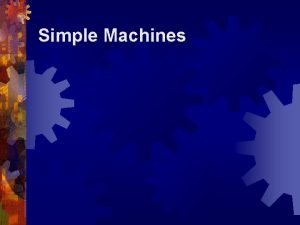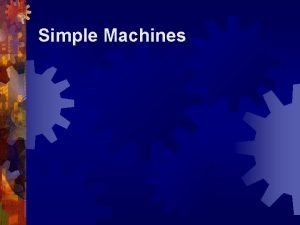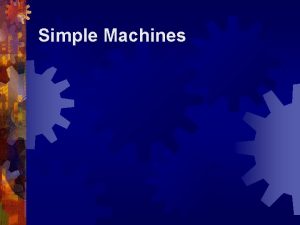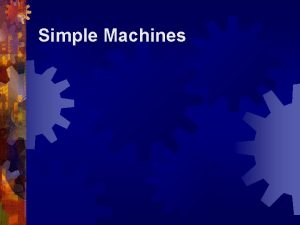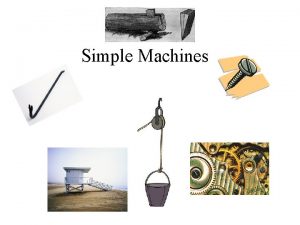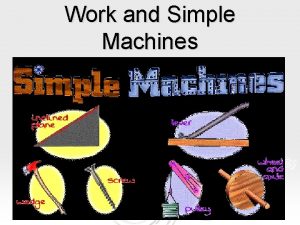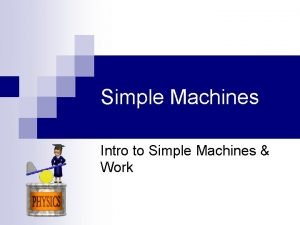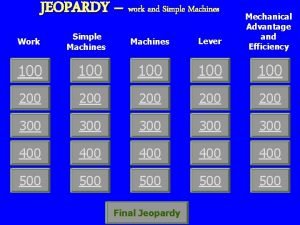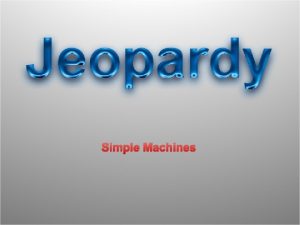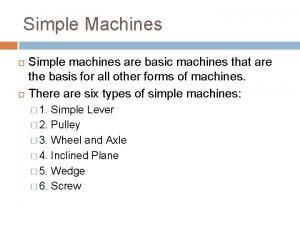Work and Simple Machines All you need to















- Slides: 15

Work and Simple Machines All you need to know about simple machines

Work • Work is when a force is exerted on an object causing it to move. • *If an object doesn’t move, NO work is done. • *The force must be in the same direction the object moves. (If you carry something it is NOT work because the force is up & the movement is horizontal).

Work (cont. ) • Formula : Work = Force X Distance • Measured in Newton meters (Nm) or Joules (J) (Named after physicist James Joule) • 1 Joule = 1 Nm • • Sample problem: • If you use 20 N of force to move a desk 10 m how much work is done? • Solution: • Work = F X D • Work = 20 N X 10 m • (D) • Work = 200 Nm or 200 J

What is a machine? • A machine is any device that makes work easier or transfers energy. • A machine makes work easier 3 ways. – Changing force exerted amount – Changing distance you exert force – Changing direction you exert force • *Input force – force you exert on the machine • *Output force (resistance force) – force exerted by the machine.

Mechanical Advantage • Mechanical advantage = output force / input force • If the mechanical advantage is greater than 1 it multiplies force. • If the mechanical advantage is less than 1 it multiplies distance • If the mechanical advantage = 1 it changes direction.

Efficiency • Efficiency is used to see how good a machine is & how much work is wasted overcoming outside forces like friction or tools that stick. • *Efficiency = output work / input work X 100% • Ideal mechanical advantage – how the machine would work without friction. Actual mechanical advantage – the actual advantage of a machine including friction. Sample problem: You go out to cut grass with a non motorized push lawn mower. You put 250, 000 J of work into mowing the work done by the mower is 200, 000 J what is the mower’s efficiency? Solution Efficiency = output work / input work X 100% Efficiency = 200, 000 J / 250, 000 J X 100%. 8 X 100% = 80% The lawn mower is 80% efficient. • •

Simple Machines • There are 6 basic kinds of simple machines. – Inclined plane – Wedge – Screw – Lever – Wheel & Axle – Pulley

Inclined Planes • Inclined planes – a flat slanted surface like a ramp. It allows you to exert your input force over a longer distance. • *The longer the inclined plane the greater the mechanical advantage if your planes height doesn’t change.

Wedges • Wedge – 1 or 2 moving inclined planes. • An axe head & a zipper are examples of wedges. • It multiplies the force to do more work

Screws • Screw- an inclined plane wrapped around a cylinder • The closer the threads of a screw the greater the mechanical advantage.

Levers • Lever- a rigid bar that moves around a fixed point. • The fixed point is called a fulcrum. • There are 3 classes of levers – 1 st class- multiplies forces or distance depending on fulcrum placement. Also changes input force direction. Ex. Scissors, pliers, seesaws. – 2 nd class- multiplies forces but don’t change direction of input force. Ex. Wheelbarrows, doors, bottle openers, nutcrackers. – 3 rd class - multiplies distance but doesn’t change input force direction. Ex. Fishing poles, baseball bats, shovels. • The mechanical advantage is greater than 1 if the fulcrum is farther from the input force but you can move it a shorter distance.

Wheel & Axle • Wheel & Axle – 2 cylinders stuck together that rotate about a common axis. • The larger (in diameter) cylinder is the wheel • The smaller (in diameter) cylinder is the axle. • Ex. Doorknobs, screwdrivers, vehicles.

Pulley • • Pulley – a grooved wheel with a rope, chain, etc. wrapped around it to pull other objects with. You change the amount & direction of the input force Pulley types: – Fixed pulleys – change direction but not amount of force. Mechanical advantage (MA) = 1. – Movable pulleys – change amount of input force. MA = 2. – Pulley systems – also called “block & tackle” The ideal mechanical advantage of a pulley system is = the number of sections that support the weight.

Compound Machines • A compound machine is a machine that uses 2 or more simple machines. • To calculate the MA of a compound machine you must calculate the MA of each simple machine in it & add them together. • Ex. Pencil sharpener (Wheel & axle & screws). • Gears are toothed wheels that fit together to help turn other objects. (They connect wheels & Axles to each other. )

Machines in the Human Body • Many body parts act like simple machines & help the body do work. • Muscles & tendons act like levers. • Teeth act like wedges.
 Chapter 4 section 1 work and machines answer key
Chapter 4 section 1 work and machines answer key Wish you a lot of strength
Wish you a lot of strength I work all day i work all night
I work all day i work all night Chapter 10 energy, work and simple machines answer key
Chapter 10 energy, work and simple machines answer key Chapter 10 energy, work and simple machines answer key
Chapter 10 energy, work and simple machines answer key Energy work and simple machines chapter 10 answers
Energy work and simple machines chapter 10 answers Physics 10
Physics 10 Types of simple machine
Types of simple machine Identify the simple machine
Identify the simple machine The 6 simple machines
The 6 simple machines All i need is the air that i breathe and to love you abba
All i need is the air that i breathe and to love you abba Attention is all you need google
Attention is all you need google Love is not all
Love is not all Money is all you need
Money is all you need Section 1 work and machines answer key
Section 1 work and machines answer key Section 1 work and machines
Section 1 work and machines




